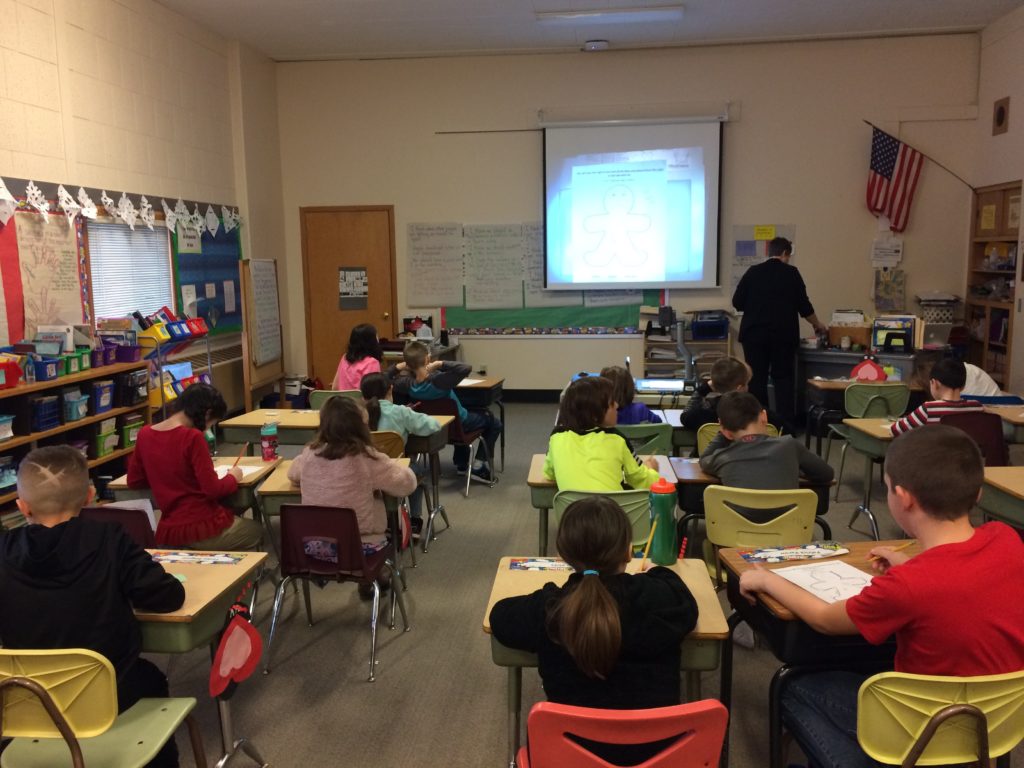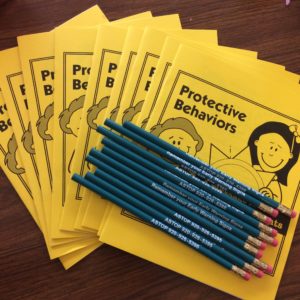In our first post about Protective Behaviors, we discussed what the program looks like when educating 4K students. (Read that post here!)
In this post, we will be covering what our presentations look like with our 1st through 4th-grade students.
Personal safety to early warning signs: How to talk to 1st-4th-grade students about sexual abuse.

Starting with 2nd-grade (and continuing into 3rd-grade), our presentations focus more on the early warning signs, safety network, and start to incorporate the difference in feeling safe, adventurous, and unsafe.
Personal safety
At the beginning of each presentation, we give the introduction of personal safety, as well as discussing what we do every day to stay safe. These presentations all have the same basic theme:
- Everyone has the right to feel safe all of the time; and others have the right to feel safe with us.
- We can talk to somebody we trust about ANYTHING-no matter how small or scary.
Starting with our 1st-graders, we review what we have talked about in 4K and Kindergarten. We review our touching rules:
- No one can touch our private body parts except to keep us clean and healthy
- We do not keep secrets about touching
We also review what we can do if someone were to touch us in an unsafe way, our safety rules:
- Say NO!
- Get Away
- Tell a Trusted Grown-Up
With our third safety rule, we talk about our “safety network” and the students get to list who their trusted adults are – typically parents, grandparent, aunts & uncles, teachers, school counselors, principals, etc.
1st-grade prevention education presentations
In our 1st-grade presentations, our Prevention Educator also reads a book that reinforces the rule of never keeping secrets about touching. The book revolves around a child seeing a friend steal an item from a teacher and initially keeping it a secret, but by the end of the book, the child tells their parents. In the book, the child feels some early warning signs, and we can relate that back to the discussion of listening to what our bodies are telling us.
2nd-grade – 3rd-grade prevention education presentations
Starting with 2nd-grade (and continuing into 3rd-grade), our presentations focus more on the early warning signs, safety network, and start to incorporate the difference in feeling safe, adventurous, and unsafe. We review what we have learned in the past, and our Prevention Educator reminds the students of the two touching rules. From there, we move into the discussion of detecting our early warning signs, “what does your body feel like when you are unsafe/scared?”. The students have the chance to share what their early warning signs are, and then the group discusses all the early warning signs. When identifying the safe, adventurous, and unsafe feelings, the students are prompted to list things that are adventurous to start to think about the difference between safe and adventurous – it’s okay for us to feel a little scared if we are still in a safe environment, but if someone else makes us unsafe, we need to act.

The students then draw out their early warning signs on a handout. This way they can think about their early warning signs and be aware of what their body might feel like when they are scared or unsafe. After discussing those early warning signs, we move on to our safety network. By tracing their hand on the paper and assigning one person to each finger, we are giving the students more than one person to go to, and encouraging persistence. At this age, we challenge them to start thinking of a “community member”, or someone who they are NOT related to and does NOT work at their school. We know that in 93% of juvenile sexual abuse cases, the child knows, loves, or trusts the perpetrator. By having them think of someone outside their family or school, we are opening the lines of communication for the child to find someone that will help them. Common answers for the community members are sport coaches, Boy/Girl Scout leaders, Boys & Girls Club workers, neighbors, family friends, or a doctor or therapist that they may see.
4th-grade prevention education presentations
With our 4th-graders, we introduce the topic of sexual abuse. Most students do very well with this subject and definition – and are very mature about it. We first do a review of what they have been learning from the ASTOP presentations in the past years (early warning signs, safety network) and then break down the definition of sexual abuse.
The definition we use to educate the students is: “When someone more powerful than you tricks, bribes, threatens or forces you into a sexual act”. We then talk about each part of the definition and what it means if someone:
- Is more powerful than you
- Tricks you
- Bribes you
- Threatens you
- Forces you
By breaking down the definition this way, the students learn that it is NEVER their fault if sexual abuse does happen, because these were the circumstances in which it happened. We go through “what if” & “how could you feel safe even if” scenarios to empower the students to listen to their early warning signs. Some of the scenarios are:
- How could you feel safe even if someone you trusted sexually abused you?
- What if sexual abuse happened a long time ago?’
- How could you feel safe even if the first person you told about the abuse didn’t help you?
- What if a friend shared that sexual abuse happened to them?
Sexual abuse can be a scary and uncomfortable topic, but by educating students, they will learn what it is, how they might feel, and what to do if it does happen.
This is the second post focusing on the “P” of our acronym – Prevention! ASTOP is a non-profit sexual abuse center located here in Fond du Lac. Since 1992, ASTOP has been able to provide free and confidential services to those who are affected by sexual assault – whether it happened 2 weeks ago, 2 years ago, or 20 years ago. It is NEVER too late to talk to somebody about what happened – that’s what ASTOP is here for! Learn more about our services here.
 Initiative of the
Initiative of the 
